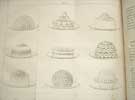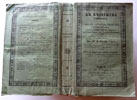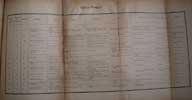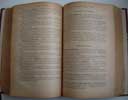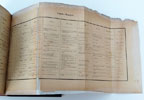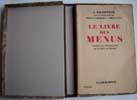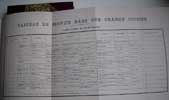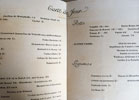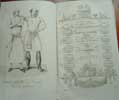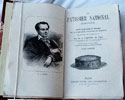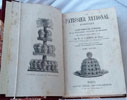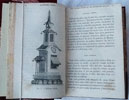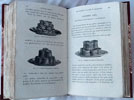Careme.
Marie Antonin
Le Patissier Pittoresque
LE PATISSIER PITTORESQUE, compose et dessine par M. ANTONIN CAREME, de PARIS, contenant cent vignt-cinq planches gravees au trait, dont cent-dix representent une variete de modeles de pavillions, rotondes, temples, ruins, tours, belvederes, forts, cascades, fountaines, maisons et hermitages; precede d'un Traite des cinq ordres d' Architecture, salon Vignole; auquel on a joint des details des ordres Cariatude, Poestum, Egyptien, Chinois et Gothique; tires du Parallele des Monumens antiques et modernes. Troisieme edition, revue, tres augmentee. A. Paris, Chez MM. J. Renourd et Cie, Tresse, Mansut, Maison, et au depot principal, rue Therese, n. 11 et a Londres, W. Jeffs, 15 Burlington-Arcade. 1842.
4th Edition. Half-Title. (List of Careme's books on verso) Engraved Title page designed by Careme.[1] Title Page.[1] 2pp Dedication to A. Monsieur Muller. 3pp Avertissement.[1] 2pp Table des Matieres. IX-XV. [1] 1-56. 1-123 Engraved Plates with versos blank. 2 Un-numbered plates with designs and versos blank. Pastedown and end-papers marbled. All the text pages very lightly browned. All the plates of pastry architecture very clean. Black morocco binding with black leather spine with gilt lettering and lines. Binding very slightly rubbed. Overall a good copy of a scarce book.
-
Careme was born in Paris and abandoned there by destitute parents in 1792 at the height of the French Revolution. He worked as a kitchen boy at a cheap Parisian chophouse in exchange for room and board. In 1798, he was formally apprenticed to Sylvain Bailly, a famous pâtissier with a shop near the Palais-Royal. Bailly recognized his talent and ambition. Carême gained fame in Paris for his pièces montées (elaborate constructions used as centerpieces), which Bailly displayed in the pâtisserie window. He made these confections, which were sometimes several feet high, entirely out of foodstuffs such as sugar, marzipan, and pastry. He modeled them on temples, pyramids, and ancient ruins, taking ideas from architectural history books that he studied at the nearby Bibliothéque Nationale. Utilizing his architectural knowledge coupled with culinary genius, some of his sugar works were so elaborate that court jesters would dance upon them while entertaining the king. He did freelance work creating pieces principally for the French diplomat and gourmand Charles Maurice de Talleyrand-Périgord, but also other members of Parisian high society, including Napoleon. While working on his confections at many private kitchens, he quickly extended his culinary skills to main courses. Napoleon was famously indifferent to food, but he understood the importance of social relations in the world of diplomacy. In 1804, he gave money to Talleyrand to purchase Château de Valençay, a large estate outside of Paris. The château was intended to act as a kind of diplomatic gathering place. When Talleyrand moved there, he took Carême with him. Carême was set a test by Talleyrand: to create a whole year’s worth of menus, without repetition, and using only seasonal produce. Carême passed the test and completed his training in Talleyrand's kitchens. After the fall of Napoléon, Carême went to London for a time and served as chef de cuisine to the Prince Regent, later George IV. Returning to the continent he served Tsar Alexander I in St. Petersburg, before returning to Paris, where he was chef to banker James Mayer Rothschild. He died in Germany at the age of 48, burnt out, and also due in no small measure, to many years inhaling the toxic fumes of the charcoal on which he cooked. He is remembered as the founder of the haute cuisine concept and is interred in the Cimetière de Montmartre, Paris.






|
|

Antiquarian category
ref number:
11000
|


